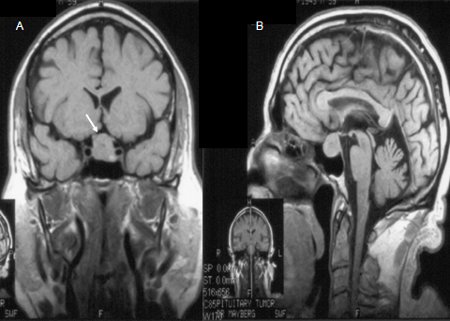Resumo
Definição
História e exame físico
Principais fatores diagnósticos
- presença de fatores de risco
- sintomas progressivos e prolongados
- cefaleias
- disfunção erétil
- testículos pequenos e moles
- ginecomastia
- amenorreia
- infertilidade
- atrofia da mama
- perda da libido
- fogacho
- diaforese
- ganho de peso
- fadiga
- anorexia
- náuseas
- vômitos
- fraqueza
- acuidade visual reduzida
- hemianopsia bitemporal
- apoplexia hipofisária
- diplopia
Outros fatores diagnósticos
- adiposidade central elevada
- massa muscular reduzida
- constipação
- intolerância ao frio
- pele ressecada
- queda de cabelos
- dificuldades de memória
- humor deprimido
- osteopenia
- perda de peso
- nervosismo
- dormência facial
- desequilíbrio
- incontinência urinária
- sinusite recorrente
- bradicardia
- convulsões
Fatores de risco
- neoplasia endócrina múltipla tipo 1 (NEM-1)
- adenomas hipofisários familiares isolados (FIPA)
- complexo de Carney (CNC)
Investigações diagnósticas
Primeiras investigações a serem solicitadas
- prolactina
- fator de crescimento semelhante à insulina-1
- hormônio luteinizante, hormônio folículo-estimulante
- subunidade alfa de hormônios glicoproteicos hipofisários
- testosterona
- estradiol
- hormônio estimulante da tireoide, tiroxina livre
- cortisol matinal
- teste de estímulo com o hormônio adrenocorticotrófico (ACTH)
- hormônio adrenocorticotrófico
- teste de tolerância à insulina para cortisol
- perfil metabólico básico
- Hemograma completo
- ressonância nuclear magnética (RNM) da hipófise com contraste de gadolínio
- TC com contraste da hipófise
Investigações a serem consideradas
- teste de estímulo do hormônio do crescimento
- perfil lipídico
- teste formal do campo visual de Humphrey ou Goldmann
- coloração imuno-histoquímica
Algoritmo de tratamento
apoplexia hipofisária
microadenoma
macroadenoma sem efeito de massa e não contíguo ao quiasma óptico
macroadenoma sem efeito de massa, mas contíguo ao quiasma óptico
macroadenoma com efeito de massa
Colaboradores
Autores
Susmeeta Tewari Sharma, MD, MBBS, MHSc
Director of Pituitary Endocrinology
MedStar Washington Hospital Center/Georgetown University Hospital
Washington
DC
Declarações
STS declares that she has no competing interests.
Agradecimentos
Dr Susmeeta Tewari Sharma would like to gratefully acknowledge Dr Gabriel Zada, Dr John Carmichael, Dr Israel Orija and Dr Amir H. Hamrahian, previous contributors to this topic. GZ, JC, IO and AH declare that they have no competing interests.
Revisores
S. Bulent Omay, MD
Assistant Professor of Neurosurgery
Yale Medical School
New Haven
CT
Declarações
SBO declares that he has no competing interests.
Andrew James, BSc, MB BCh, MD, MRCP, FRCP
Consultant Endocrinologist
Newcastle Hospitals NHS Foundation Trust
Royal Victoria Infirmary
Newcastle
UK
Declarações
AJ declares that he has no competing interests.
Federico Roncaroli, MD
Reader in Neuropathology and Honorary Consultant in Neuropathology
Neuropathology Unit
Department of Clinical Neuroscience
Division of Neuroscience and Mental Health
Faculty of Medicine
Imperial College
London
UK
Declarações
FR declares that he has no competing interests.
Créditos aos pareceristas
Os tópicos do BMJ Best Practice são constantemente atualizados, seguindo os desenvolvimentos das evidências e das diretrizes. Os pareceristas aqui listados revisaram o conteúdo pelo menos uma vez durante a história do tópico.
Declarações
As afiliações e declarações dos pareceristas referem--se ao momento da revisão.
Referências
Principais artigos
Molitch ME. Diagnosis and treatment of pituitary adenomas: a review. JAMA. 2017 Feb 7;317(5):516-24. Resumo
Mercado M, Melgar V, Salame L, et al. Clinically non-functioning pituitary adenomas: pathogenic, diagnostic and therapeutic aspects. [in spa]. Endocrinol Diabetes Nutr. 2017 Aug-Sep;64(7):384-95. Resumo
Aghi MK, Chen CC, Fleseriu M, et al. Congress of neurological surgeons systematic review and evidence-based guidelines on the management of patients with nonfunctioning pituitary adenomas: executive summary. Neurosurgery. 2016 Oct;79(4):521-3.Texto completo Resumo
Esposito D, Olsson DS, Ragnarsson O, et al. Non-functioning pituitary adenomas: indications for pituitary surgery and post-surgical management. Pituitary. 2019 Aug;22(4):422-34.Texto completo Resumo
Minniti G, Flickinger J. The risk/benefit ratio of radiotherapy in pituitary tumors. Best Pract Res Clin Endocrinol Metab. 2019 Apr;33(2):101269. Resumo
Artigos de referência
Uma lista completa das fontes referenciadas neste tópico está disponível para os usuários com acesso total ao BMJ Best Practice.

Diagnósticos diferenciais
- Adenoma secretor de prolactina (prolactinoma)
- Adenoma secretor de hormônio do crescimento (acromegalia)
- Adenoma secretor de hormônio adrenocorticotrófico (síndrome de Cushing)
Mais Diagnósticos diferenciaisDiretrizes
- Suspected cancer: recognition and referral
- Clinical practice guideline on functioning and nonfunctioning pituitary adenomas in pregnancy
Mais DiretrizesConectar-se ou assinar para acessar todo o BMJ Best Practice
O uso deste conteúdo está sujeito ao nosso aviso legal